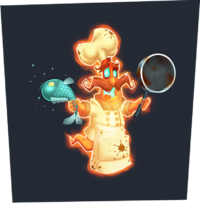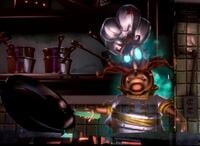Chef Soulfflé
| Chef Soulfflé | |
|---|---|

| |
| Floor | Mezzanine |
| HP | 350 |
Chef Soulfflé is the fourth boss encountered in Luigi's Mansion 3. His name is a pun on "soul", referencing ghosts, and "soufflé", a French baked egg dish. He is encountered and fought in the Mezzanine after Luigi locates him in the floor's kitchen. Defeating Chef Soulfflé rewards Luigi with the elevator button that grants access to The Great Stage, after retrieving it from some mice.
It is actually possible to get inside the Kitchen that Soulfflé makes his lair in as soon as the Suction Shot is unlocked (used to remove the sign blocking both doorways leading from the Grand Lobby), but to prevent the game from progressing on early, Chef Soulfflé will not appear until after Kruller has been defeated.
Battle
Luigi and Gooigi end up exposing Chef Soulfflé after sucking up a huge amount of smoke (presumably caused by his attempts at preparing food). After discovering Luigi and Gooigi in his kitchen, he drops the fish he was flipping and angrily confronts them.
Chef Soulfflé wields a frying pan as his main weapon, spinning around to attack Luigi, dealing 20 damage on a successful hit, and using it as a defense from the Strobulb. In order to defeat him, the player has to take it from him with the Suction Shot or fling pumpkins and/or watermelons at him to disarm him of his pan allowing for an opportunity to flash him and stun him to suck him in. If Luigi runs out of pumpkins and watermelons, Soulfflé will toss fish (similar to the one in his introduction) at him which can be thrown the same way. Once defeated, he struggles to escape before being sucked in, releasing several fish in addition to The Great Stage's elevator button, although a mouse steals the button before Luigi can retrieve it.
Names in other languages
| Language | Name | Meaning | Notes |
|---|---|---|---|
| Japanese | ムッシュテイシェ[?] Musshu Teishe |
French title "monsieur" + a corruption between「亭主」(teishu, owner) and possibly「シェフ」(shefu, chef) | |
| Chinese | 慕修提歇[?] Mùxiūtíxiē |
Transliterated from the Japanese name | |
| Dutch | Kok Eauvain[?] | Pun on "coq au vin" and "kok" (chef) | |
| French | Krem Brûlé[?] | Pun on "crème brûlée" | |
| German | Jacques Cuisinier[?] | Cook (in French) Jacques | |
| Italian | Chef Panique[?] | "Chef Panic" in French | |
| Korean | 무슈 티세[?] Musyu Tise |
Transliterated from the Japanese name | |
| Spanish (NOA) | Chef Ocassoulet[?] | A cassoulet is a rich, slow-cooked casserole containing meat (typically pork sausages, goose, duck and sometimes mutton), pork skin (couennes) and white beans (haricots blancs), originating in southern France | |
| Spanish (NOE) | Pescanislao[?] | Pun on "pescado" (fish) and male given name "Estanislao" |
